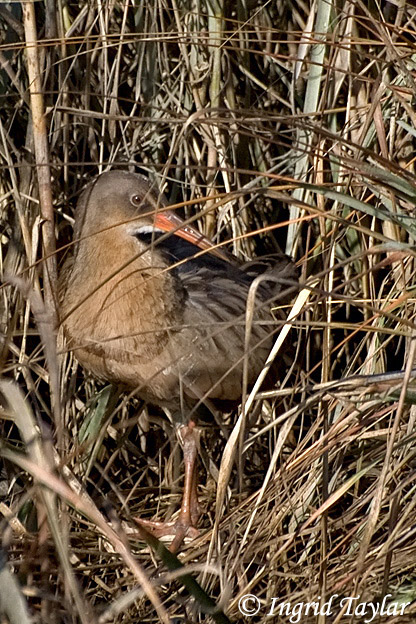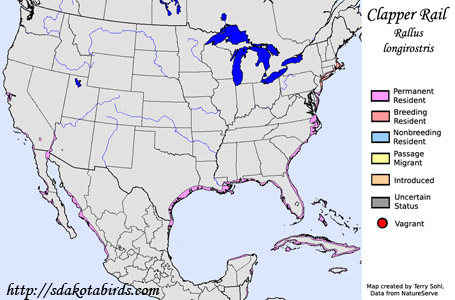Clapper Rail
Rallus longirostris
| Length: 15 inches | Wingspan: 20 inches | Seasonality: Non-resident in South Dakota |
| ID Keys: Rail shape, long heavy orange bill, dark streaking on gray-brown back, barring on rear blanks, plain on belly and chest | ||
 The
Clapper Rail is a large rail that is primarily found in salt marshes of the
Eastern United States. Scattered populations have also been found
along the West Coast, but the species is rare and localized in the West.
They are very similar to the King Rail,
with which they sometimes interbreed. Some scientists consider the two
to be a single species. The two species do differ greatly in habitat
preference however, with the Clapper Rail preferring salt-water wetlands and
the King Rail preferring fresh water.
The
Clapper Rail is a large rail that is primarily found in salt marshes of the
Eastern United States. Scattered populations have also been found
along the West Coast, but the species is rare and localized in the West.
They are very similar to the King Rail,
with which they sometimes interbreed. Some scientists consider the two
to be a single species. The two species do differ greatly in habitat
preference however, with the Clapper Rail preferring salt-water wetlands and
the King Rail preferring fresh water.
Habitat: In much of their range, Clapper Rails are only found on salt marshes. In the southwestern U.S., a subspecies is found in freshwater marsh along the Colorado River, while in Florida, some can be found in mangrove swamps.
Diet: Feeds on a variety of aquatic life depending upon location. Diet may include crustaceans such as crabs or crayfish, mollusks, aquatic insects and their larvae, small fish, or small amphibians. They may also occasionally feed on plant matter, mostly seeds.
Behavior: Clapper Rails forage by walking through the wetland vegetation. Much of the foraging is done at low tide, where they have better access to crustaceans, mollusks, and other food items. Most foraging is done by simply picking up food items when spotted, but they will also occasionally probe in the mud for food with their long bills.
Nesting: The nest of a Clapper Rail is a cup of grasses and other herbaceous vegetation, built in grasses or reeds in a wetland. Both the male and female help to build the nest, and both parents will help to incubate the eggs. Both parents help to raise the young.
Song: Has both a grunting series of notes, and a kek-kek-kek-kek call consisting of 4 or 5 individual notes.
Migration: Clapper Rails are permanent residents throughout most of their range. However, on the Atlantic coast, the northern most populations do move south for the winter.
Interactive eBird Map: Click for access to an interactive eBird map of Clapper Rail sightings
Similar Species: King Rail, Virginia Rail
Conservation Status: Populations in the western U.S. are seriously endangered. Populations in the eastern U.S. have also experienced sharp declines, due to habitat loss. Despite the local reductions in populations, the species is widespread (with populations extending into South America) and populations in North America are locally strong where suitable habitat remains. The IUCN currently lists the Clapper Rail as a species of "Least Concern".
Further Information: 1) Cornell's All About Birds - Clapper Rail
2) USGS Bird InfoCenter - Clapper Rail
3) North Carolina Wildlife - Clapper Rail
Photo Information: Photo taken by Ingrid Taylar - November 30th, 2008 - Arrowhead Marsh - Photo licensed under Creative Commons Attribution 2.0 Generic License
| Click below for a higher-resolution map |
 |
| South Dakota Status: Non-resident in South Dakota |
